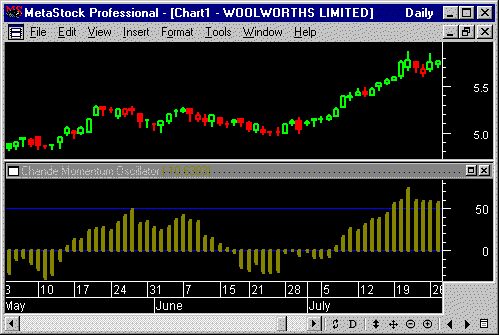|
Chande Momentum Oscillator

Description
The Chande
Momentum Oscillator (CMO) was developed
by Tushar Chande. A scientist, an
inventor, and a respected trading system
developer, Mr. Chande developed the CMO
to capture what he calls “pure
momentum". For more definitive
information on the CMO and other
indicators we highly recommend the book
The New Technical Trader by
Tushar Chande and Stanley Kroll.
The CMO is
closely related to, yet unique from,
other momentum oriented indicators such
as Relative Strength
Index,
Stochastic,
Rate-of-Change, etc. It is most
closely related to Welles Wilder’s RSI,
yet it differs in several ways:
-
It uses
data for both up days and
down days in the numerator, thereby
directly measuring momentum.
-
The
calculations are applied on
unsmoothed data. Therefore,
short-term extreme movements in
price are not hidden. Once
calculated, smoothing can be applied
to the CMO, if desired.
-
The
scale is bounded between +100 and
-100, thereby allowing you to
clearly see changes in net momentum
using the 0 level. The bounded scale
also allows you to conveniently
compare values across different
securities.
Interpretation
The CMO can
be used to measure several conditions.
Overbought/oversold: The primary
method of interpreting the CMO is
looking for extreme overbought and
oversold conditions. As a general rule,
Mr. Chande quantifies an overbought
level at +50 and the oversold level at
-50. At +50, up-day momentum is three
times the down-day momentum. Likewise,
at -50, down-day momentum is three times
the up-day momentum. These levels
correspond to the 70/30 levels on the
RSI indicator.
You could
also establish overbought/oversold entry
and exit rules by plotting a moving
average trigger line on the CMO. For
example, if you are using the default
20-period CMO, a 9-period moving average
may serve as a good trigger line. Buy
when the CMO crosses above the 9-period
trigger line; sell when it crosses
below.
Trendiness: The CMO (much like the
VHF indicator),
can also be used to measure the degree
to which a security is trending. The
higher the CMO, the stronger the trend.
Low values of the CMO show a security in
a sideways trading range.
You may
find the CMO helpful in establishing the
entry and exit rules of a trend
following system. Enter when the CMO is
high and exit when it moves lower.
Divergence. Although not
specifically mentioned in Mr. Chande’s
book, you could also look for divergence
between the CMO and the price, as is
often done with other momentum
indicators. See the
discussion about divergence in the
Interpretation section of RSI.
Other:
Although not specifically mentioned
in Mr. Chande’s book, you may also look
for chart formations (head and
shoulders, rising wedges, etc.), failure
swings, and support/resistance. See the
discussion on these
methods in the Interpretation
section of RSI. |